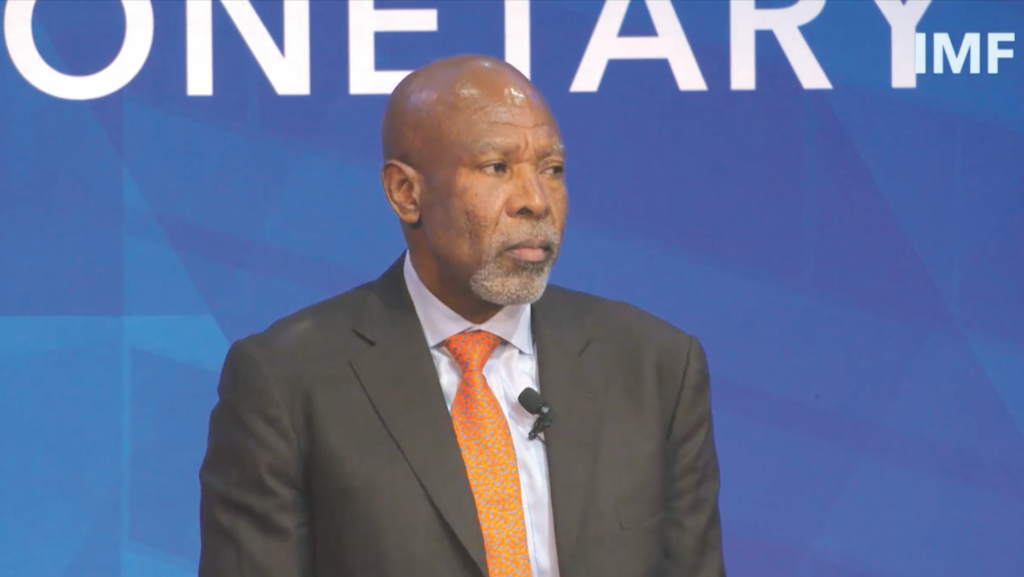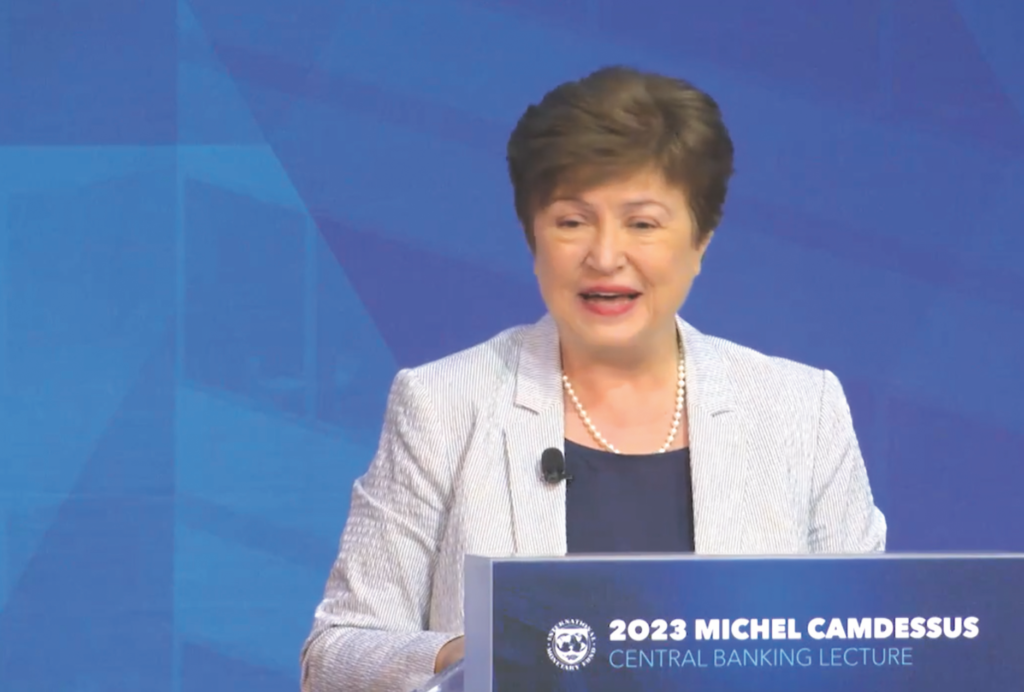2023 Michel Camdessus Central Banking Lecture
In an integrated world where financial globalization has seen an accelerated movement in capital across borders, many are pressing the pause button to reassess the strategy of relying excessively on external capital flows as a growth driver in times of global volatility.
Lesetja Kganyago, Governor of the Reserve Bank of South Africa, addressing the tenth annual Michel Camdessus Central Banking Lecture 2023 organized by the International Monetary Fund, spoke at length on how emerging markets could leverage the benefits of capital flows for sustainable growth by listing out a set of best practices to optimize results. He underscored the importance of the quality of institutions in making the right policy choices and the quality of human capital empowered to run them, with the capacity to direct capital inflows into productive activities.
By Jennifer Paldano Goonewardane.

Lesetja Kganyago, Governor of the Reserve Bank of South Africa, in conversion with Kristalina Georgieva, Managing Director, IMF.
Investments and economic growth have lulled during periods of global financial volatility. The financial crisis of 2007-2008, the COVID-19 pandemic, and Russia’s invasion of Ukraine and its fallout have had significant economic and social impacts on countries worldwide. Inefficient leadership and mismanagement of capital flow over many years is another reason for slow growth. The most affected countries struggle to narrow their current account deficits amid an inability to repay or refinance sovereign debt.
Investments and economic growth have lulled during periods of global financial volatility. The financial crisis of 2007-2008, the COVID-19 pandemic, and Russia’s invasion of Ukraine and its fallout have had significant economic and social impacts on countries worldwide. Inefficient leadership and mismanagement of capital flow over many years is another reason for slow growth. The most affected countries struggle to narrow their current account deficits amid an inability to repay or refinance sovereign debt.
The role of capital flows in a financially globalized world has been varied. Two to three decades ago, the role of capital flows was considered with favor, accompanied by calls for liberalizing it. Today, economists and sceptics look at it with caution.
Governor Kganyago pointed out that emerging economies have followed different trajectories in this regard, some with an overarching focus on capital flow dependence for growth, to others following a more guarded approach. As emerging economies sought ways to increase capital inflows to circumvent the current account deficits, they made the case in favor of it. It was low-cost financing at low-interest rates with the incentive to engage in sound policymaking. However, a debate on the role of capital flows in stimulating sustainable growth in emerging markets and developing countries is getting louder by the day. The volatility of cross-border capital flows, as evidenced during global financial crises, has led to renewed calls for a cautionary approach to overreliance to spur growth. Capital flows are like a double-edged sword. In good times it can be the source of development, but it turns out to be a bane in times of crisis. The governor’s words brought home the truth surrounding the risks of depending excessively on external financing, the problems of a surge in capital flows to emerging markets in the absence of proper institutional arrangements, and the role of policymakers in such economies.
Today, even institutions like the IMF are changing their tune, taking up a cautionary approach by introducing a new analytical macroeconomic framework as a guide to building suitable policy responses while opining that the impact of capital flow volatility will be country-specific, hence calling for unique policy responses over a “one size fits all” answer.
What’s the Big Fuss about?
Today a vocal consensus is building that is anti-capital flows. The rising opposition to capital flows, pointed out by Governor Kganyago, has been driven partly by the behavior of the US monetary policy and its varying stances. Fed responses to crises have forced emerging market central banks to keep a close watch and react accordingly. Fed decisions have become so crucial to some economies that they schedule policy meetings the day after the Fed meets. The Feds’ policy responses vary, hence the growing apprehension about capital flows. For instance, the Quantitative Easing Program lowered regulation after the 2007-2008 financial crisis. However, it tightened rules in 2013, leading to the taper tantrum episode and continues to follow an aggressive monetary policy impacting economies worldwide, especially in developing countries. In turn, emerging economies and developing countries have experienced the wrath of the US monetary policy in increasing interest rates, borrowing costs, and consumer prices.
In the face of the increasing negatives to capital flows, the new narrative propounds de-globalization, “counter-cultural” to integration and capital flows. It calls for a shift from the earlier discourse that promoted integration. Today calls for de-globalization are becoming louder in the context of geopolitical tensions, the US-China rivalry leading to economic fragmentation and technological decoupling, and the rise of populist politics. The discourse also points to the troublesome nature of financial globalization and its paradoxes, with economists decrying the lopsidedness in the flow of capital from rich countries to developing countries.
Economist Arvind Subramanian, a vocal advocate for financial de-globalization, argued in 2022 that “Capitalism must be saved from its financial rentiers and financial de-globalization is a good place to start”, being critical of emerging economies’ attempts at pinning their hopes on a coordinated global monetary policy and illusions of international cooperation. He denounced the victimhood narrative of the emerging and developing countries, calling for a more guarded approach to capital mobility by policymakers, focusing more on capital that would be advantageous.
Opponents of capital flows and financial integration who support domestically sourced financing turn to Asian countries, with empirical evidence as success stories, the China story being the most recent example. Fast-growing economies like China were capital exporters, despite starting poorer and with smaller capital stocks than the economies in which they invested their surplus savings. However, these countries experienced crises when they eventually opened to capital flows in the 1990s, disrupting their remarkable development trajectories.
The Poster Child Making the Case for Capital Flows
The United States, Canada, New Zealand, and Australia have relied heavily on capital inflows to spur growth through investments, demonstrating outstanding growth records.
Governor Kganyago spoke extensively on Australia and its successes with capital inflows. He argued that Australia’s incredible development goes back to the 19th century, recording high living standards from the mid-19th century and the highest at the start of the 20th century. Australia’s current account deficit remained relatively small throughout the mid-20th century when it focused on drawing investments to develop its natural resources, obtaining significant and sustained capital inflows. This feat would have been impossible with a total reliance on domestic savings. Therefore, the success of Australia’s economic model, pointed out by the governor, is hard to challenge.
Another crucial factor in Australia’s favor or, for that matter, any country in terms of attracting foreign capital flows is its reputation as a reliable ground for investment, which given Australia’s formidable and credible macroeconomic policies, had earned investor confidence, together with a reasonable degree of price stability and resilient financial sector.
However, the Australian story is not the be-all and end-all of economic growth. Australia, too had its downturns, demonstrating that maintaining a sizeable current account deficit could be troublesome as well.
The country found itself with a more significant sustained current account deficit in the 1970s and early 1980s, making it a cause of policy concern amid insufficient capital inflows, a change driven by a reversal in the fiscal policy, resulting in the outflow of forex reserves to fund the deficit. The floating of the Australian dollar and budgetary consolidation did not bring about the expected outcome, with the substantial current account deficit persisting. As policies could not contain the significant current account deficit, it gave rise to the “consenting adults” view, which advocated that current account deficits represent the outcomes of optimal decisions made by private agents, and hence policy should not attempt to influence the current account balance.
The above argument that consenting adults privately contract current account deficits is an insufficient view in defining the experiences of other countries. The governor pointed out that private sector flows can be dangerous. During the Eurozone sovereign debt crisis, Ireland and Spain were clear examples. This crisis erupted with the stoppage of capital inflows into these countries heavily dependent on foreign lending to cover their current account deficits. They were thrown into a precarious situation of high debt and deficit levels, making it harder for them to repay or refinance government debt.
Why Australia becomes a poster child for those favoring capital flows for growth is a lesson for other countries. According to Governor Kganyago, for Australia to reap extensive returns from external capital flows demonstrates that the government had the suitable mechanisms and institutions to ensure that the capital got channeled into productive assets.
Detractors may argue that Australia was fortunate to be endowed with high-value natural resources that attracted substantial capital inflows. But that argument would become null when others with similar natural resources didn’t get it right. Unlike countries that have demonstrated boom-bust growth cycles, Australia has shown consistent capital flows productivity since the 19th century, a testament to good policy choices, the quality of institutions, and the human capital empowered to run them. Australia is also an example of how a country can absorb large capital inflows over considerable periods and use them to support high levels of prosperity.
South Africa Pursuing the Australian Dream
South Africa has long favored the Australian route, explained the governor. When South Africa came out of apartheid, the Mandela Government had sought access to global financial markets – to attract more foreign savings, apply fiscal discipline to improve the country’s investment profile, reduce the government’s demand for domestic savings to keep interest rates low and steer more private sector investment. But what the Mandela Government didn’t want to do was to accumulate an unsustainable current account deficit by allowing heavy public and private sector borrowings in the face of low domestic savings, which would weaken the Rand and drive up inflation. If so, the central bank would have to increase rates, thereby slowing growth.
Described as the golden era of the country’s macroeconomic policy, the model was a success despite the intermittent downsides of opening to capital flows. During this period, investment rose to 20 per cent of the GDP from 15 per cent at the end of apartheid, driven predominantly by portfolio flows, which were de-risked by a floating currency and minimized foreign currency borrowings across the economy.
The Trajectory Changes
The governor described the 15 years after 2009 as a mirror image of the first 14 years of South African democracy. From 2009 onwards, the country experienced a steady decline in investments and growth, marked by incomplete recoveries.
Explaining the scenario, Governor Kganyago said South Africa went well for much of the decade after the global financial crisis with ample access to foreign capital, helped by very low-interest rates in major economies. The average current account deficit until the onset of COVID-19 was just over three per cent of GDP. Portfolio flows were the primary source of deficit financing. However, the investment composition for this period shifted markedly towards government debt and away from private sector assets such as equities. During the boom of the 2000s, the government and public corporations in South Africa absorbed just 16 per cent of all portfolio flows, which then rose to 78 per cent in the next decade. Scholars have rightly observed that capital flows into sovereign debt have been a significant source of crises since at least the 19th century, in the case of South Africa, leading to a twin deficit of a fiscal and current account deficit, a departure from a “consenting adults” situation.
The Three Distinct Impacts
One, the steady flow of money available to South Africa after the global financial crisis led to deficient policymaking. The problem was homegrown. Rather than scrutinize and cut back on unnecessary spending, the steady flow compromised scrupulous policymaking and application a challenge.
Two, those flows led to a swell-up in the sovereign debt position. Unlike equity investments, debt is problematic because its risks mostly fall on the borrower. Therefore, increasing sovereign debt becomes difficult for economies as it erodes a government’s creditworthiness that extends to the credit profiles of firms and households. That led to higher taxes. It also led to lower public sector investment due to accommodating higher interest payments.
Three, capital flows eroded potential growth. The quality of institutions is sacrosanct for a country’s development. But as evidenced in South Africa, debt became the crutch that weakened its institutions through patronage and corruption. The result? It led to an exodus of skilled and diligent public servants exiting those institutions. Despite the country’s macroeconomic framework providing resilience with a floating exchange rate, low foreign currency debt exposures, and careful financial sector regulation, those incentives went unharnessed by decisions to direct inflows into unproductive channels, thereby impeding growth.
South Africa’s return to its mid-1990s conditions by drifting away from good development choices and good governance has been described as the “hollowing out of a country’s economy and institutions” by economist Darren Acemoglu. The country’s constitution protects the South African Reserve Bank, hence having the ability to maintain liberality. Moreover, officers of integrity thwarted any attempts at hollowing out institutions like the SARB and the Treasury. However, political appointees and individuals with questionable characters drove the best institutions to the ground, requiring them to be rebuilt literally from scratch. Despite the consequences of excessive borrowing, lack of domestic savings, and limited non-resident appetite for South Africa’s assets, the governor is against a prohibitionist approach to capital flows. He suggested a risk management approach by working in tandem, as indicated by the IMF, which, while acknowledging the benefits of capital flow, encourages a capital flow toolkit-backed risk controls and macro-prudential measures.
The intelligent use of capital flows in one period spurred prosperity, while abuse in another thrust the economy into instability. Where investment opportunities exceed local savings, closing the door to capital flows will impact significant growth.
Policy Tools to Manage Risks
One is to adjust the regulatory treatment for government bond holdings by obligating banks to hold capital against them instead of treating them as riskless. That, however, would not directly affect non-resident investment decisions.
A second tool would be to develop a suitable Sovereign Debt Restructuring Mechanism, as proposed by the IMF, to apply bankruptcy reorganization principles to resolve sovereign debt crises. Such a mechanism would spur lenders to scrutinize borrowers. A more benign tool, suggested the governor, would be to accumulate forex reserves, which are vital for risk management.
In addition to these tools, the governor proposed a more mature and responsible macro policy narrative that moves from cherry-picking the points for policy discussion, not the most suitable to fit in with a course that some seek to promote and validate.
While the pros and cons of capital flows’ is the topic of much debate today, accessing the global financial system nonetheless offers tremendous opportunities for emerging economies. Small economies could run annual current account deficits at an optimal 60 per cent of the GDP. Making the case further for capital flows, the governor pointed out that developing countries’ interest rates are just a short distance from the rich countries. On a per capita basis, capital stocks owned by middle-income countries are less than a third of those in the United States. Moreover, paying higher interest rates to attract investment would boost labor productivity. Still, a comparison of real rates between rich countries and middle-income countries does not yield a massive difference – the policy rates in rich countries averaged about minus one per cent compared to just under plus one per cent in middle-income countries in the past two decades.
In the final analysis, the volatile history surrounding capital flows that have given way to impassioned debate in recent years is a conflict between budget and capacity constraints. Countries needing more implementation capacity may attract significant capital inflows that give them higher spending power. However, without institutional capacity, such inflows will fall short of being used in productive activities.
It’s more like a Jekyll and Hyde pattern. At its best, capital flows support investment, reduce financing costs and accelerate convergence in developing economies, especially where domestic savings fall short of investment needs. At its worst, it can drive economies into a crisis of significant proportion, even defaults and bankruptcy. South Africa is a good case in point. The intelligent use of capital flows in one period spurred prosperity, while abuse in another thrust the economy into instability. Where investment opportunities exceed local savings, closing the door to capital flows will impact significant growth.
Governor Kganyago gave his verdict. While relying on capital flows for growth may not be the preferred strategy, adopting risk controls and nurturing institutions able to deliver productive investment choices may be the best way for emerging economies to reap the benefits of capital inflows for growth and prosperity.
“One of the strongest lessons I have learnt as a policymaker is that poor countries are poor not because they do not have money but because they do not use money effectively. Too often, there is a tendency to look at a problem, cross out the solution, and focus on raising the cash. Implementation is just a black box. Good policymaking starts with implementation, and the financing need should reflect what can be used effectively.”
Lesetja Kganyago, Governor of the Reserve Bank of South Africa

Lesetja Kganyago, Governor of the Reserve Bank of South Africa.

Kristalina Georgieva, Managing Director, IMF.





